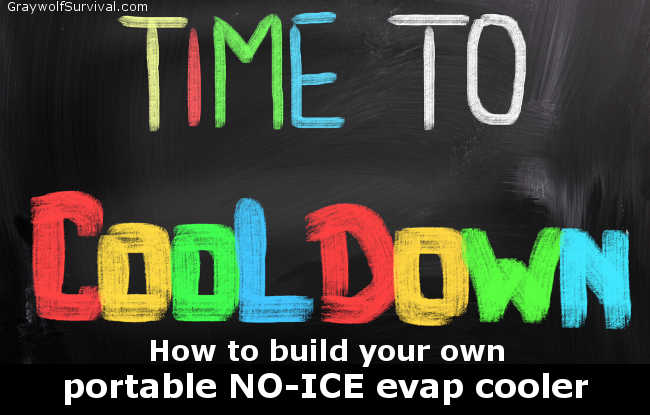 I finally got to go camping again a couple weeks ago and wish I would have had one of these 5 gallon bucket DIY air conditioners. Since we were going camping for several days and in a location without electrical hookup and a lot of my neighbors were going (some of whom had never camped), I figured I’d make a portable solar powerbox. The box worked well. It was just a proof-of-concept so there are some improvements that’ll be made to it but it had no problem keeping up with my Yaesu FT-857D ham radio
I finally got to go camping again a couple weeks ago and wish I would have had one of these 5 gallon bucket DIY air conditioners. Since we were going camping for several days and in a location without electrical hookup and a lot of my neighbors were going (some of whom had never camped), I figured I’d make a portable solar powerbox. The box worked well. It was just a proof-of-concept so there are some improvements that’ll be made to it but it had no problem keeping up with my Yaesu FT-857D ham radio, lighting, charging electronic devices and filling up air mattresses. Eventually I’d like to get one of these Goal Zero Yeti 400 Solar Generator Kits
but I may just see if I can get by with one of these smaller solar generator kits
.
Since this weekend at my house is now 118 degrees (I live in Phoenix), I started thinking hard about what I’d do to survive if I had to live for a while outside in this weather. Obviously, to survive in the desert, you need an ample supply of water. More water than other places. But just drinking water won’t keep you very cool Sweat only goes so far. You need to find a way to get cool.
Now there are a LOT of designs out there that you’ll see a bucket or a cooler with a fan sticking out of them. You need to have ice to make those ones work. No problem if you happen to have a freezer nearby to make ice but this design is for more long-term use in places that you can only find water. If you can’t find water, you’re pretty much dead anyway. If you have solar, that’s all you’ll need to run it.
This design uses no ice.
Provided I had water available, since I have a viable power supply, I thought I’d make a portable evaporative cooler (not really a traditional air conditioner but it does condition the air), or swamp cooler as they’re called out here. I figured I’d make this post before my build, as I do some research and get the parts so you’d have enough information to build your own. I’ll post my version 1.0 build once it’s built and working.
In dry environments, they can work very well. They use a LOT less energy than an air conditioner unit so I won’t have to increase the power capabilities of my system to work it, and they can reduce the temperature by up to 30 degrees as well as take out the dryiness in your tent while you sleep. If SHTF, this may be something that could make your life more comfortable or even save it.
In case you think you need to be in a desert to use this thing, here are the possible temperature reductions you can get out of it in different humidities:
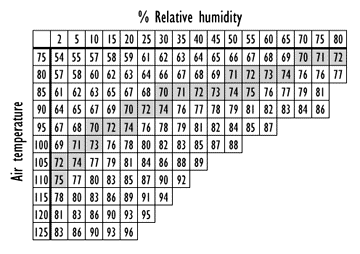
Since I have a pretty small tent (I have a Koppen Maelstrom 2 but I need something self-standing and don’t like entering from one end so I’m thinking about getting one of these Marmot Limelight 2’s), cooling it down isn’t gonna be much of a problem.
This is what I was looking for:
- Runs off 12V DC so I can either use the solar panel or connect to a battery. It’ll have a 12V power plug for this.
- Draws as little power as absolutely possible.
- Has the ability to connect to a larger water source easily so it won’t have to be continually refilled or have a large reservoir.
- Very portable. Backpackable if possible.
That being said, let’s look at how a swamp cooler actually works.
I was at my neighbor’s house last night, where it was 117 degrees after dark. After getting out of the pool a few drinks later, it was quite chilly. The temperature had only dropped 3 degrees while we were in there but it felt chilly enough that it was a little uncomfortable without grabbing a towel. Why is this?
When water evaporates, it takes energy to convert it from a liquid to a gas. All you need is to have dry air contact water. With a swamp cooler, that air that now gave up some of its latent temperature to the conversion is then blown into the room. Simple.
One thing to keep in mind is that the wet bulb temperature of the air is the coolest it can be brought to by evaporation. If you continue to pump in humid air to a room without releasing the wet air, you’ll eventually get to a point where the cooler isn’t gonna help. As time goes on, you’ll then have a hot humid room. Worse than when you started. Let’s make sure we don’t do that with this system.
In a swamp cooler, water is dripped down through a medium, usually a mat or pad that looks like a flat piece of hay or blue fiber. This mat is designed to give the water as much surface area as possible to contact the air going through the system. The more surface area of water, the more efficient the system for the most part. Also, the more air that goes through will cool down the room quicker. But, these two fight each other like two hens with a worm because as you blow air faster, it dries out the pad. Since the pad then has a dry spot, not only is there less wet surface area to convert, the air has an easier time going through the dry part so it doesn’t work as well.
This means that you have to have as much pad area as possible, keep it continually wet somehow, and blow as much dry air through it as you can.
Also, it means that bacteria can grow if you don’t keep the system clean with periodic maintenance. There’s a product called Holmes S1708PDQ-U Humidifier Bacteriostat that works well for this and a bottle would last quite a long time with a swamp cooler this small.
So how are we gonna do this and still meet all the criteria that I mentioned before?
How Figjam made his 5 gallon bucket air conditioner
What we’re gonna do is start with the basic idea that a guy came up with for cooling that is laid out in this instructible. Great way to use easy-to-find stuff to make your life more comfortable or survivable.
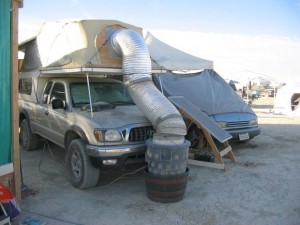
Now, as you can see, this design is a bit large. Too large for my purposes. Luckily since the theory is so simple, it’s easily adapted and down-scaled. Figjam (Fuck Me I’m Good, Just Ask Me) did this for his trips to the Playa at Burning Man (always a hotbed of inventions and way hot and dry). He also explained how he did it in this post. You gotta give the guy props for this.
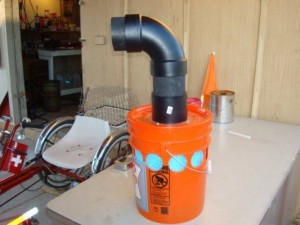

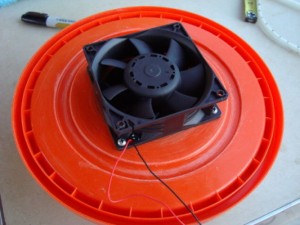
Now that’s more like it. Cheap, portable, low power, and works. He took a 5 gallon bucket, wrapped the inside with two layers of swamp cooler matting, made a loop of hose above it connected to a submersible pump and ran a fan out the top with piping. You could then attach that pipe to a vent hose and pump it into your shelter.
So, I’m gonna base my design loosely on that one but make a couple changes.
One, I don’t like having to use both AC and DC to run the thing, especially since the AC will take more power. Not much, mind you, but the more efficient I can make the system, the less power I’ll have to supply. So to that end, I’m gonna use a 12V DC submersible pump. It draws about 350 milliamps, which at 12Volts is about 4.2 watts. For that, I get a hair over a gallon per hour. Should be just about right. I may end up changing this pump later for a better one but whatever.
This pump will hopefully give me the flowthru rate I need to keep the padding wet at all times but not take too much energy. If it doesn’t work, I’ll just switch to either a larger 12V pump or scrap the idea altogether and go AC. For about $10 though, I gotta at least try it. If it does work, I may look for an even more efficient DC pump for a bit more money.
Another thing I wanna change is the fan. I was originally going to use the same kind of computer fan that Figjam used but then decided it didn’t have enough flowthru. This is what he’s using:
At maximum speed, this one pulls about 45 CFM (Cubic Feet per Minute) and should draw about 1.8 Watts.
I think I’ve settled on the Fan-Tastic Endless Breeze 12V Fan for my project. It runs off 12v, is super reliable, puts out 900 CMF (20 times what the fan above does) and pulls about 2.6 amps on high or 1 amp on low. If I combine it with the 12v pump (providing it can push enough water), I’ll have a great setup. If not, this fan would be really nice to have anyway. I love this fan.
I was going to use the Attwood Blower H20 Resist. It pulls 2.7 amps but blows at 240 CFM, and since it’s inline with the pipes, it pulls all the air through more efficiently than open air. It’s like having over 5 of those computer fans above and if the DC pump works, I’d be able to afford the increased amps in this area. 2.7 amps is a LOT more amps than the 150-200 or so milliamps that the computer fan’ll draw but it would work in certain applications. Due to the static pressure that may end up building in the system with so much airflow, and the effect that velocity may have in the cooling efficiency, I’ve decided to go with the Endless Breeze first but a different configuration may use this one. This one would require piping the air in/out of it so I’m not sure how I’d configure it.
Another thing I wanna do is be able to hook the box to other water somehow but not have to worry about it overfilling. To do this, I’m gonna hook up a simple mechanical float shutoff valve.
With that, I can keep the internal reservoir full but not have to either keep filling it every hour (the system is gonna go through somewhere around a gallon an hour or so) or have to have a gigantic reservoir. I want this thing to be something you can carry with you if possible, and if not, at least not take up a lot of room in a vehicle.
I haven’t yet figured out what I’m gonna use as a box to hold it all. I may end up using a 5 gallon bucket DIY air conditioner (using a 5 gallon bucket) like Figjam did but I need to see how my current setup is gonna work. What I’d rather do is come up with a way to make it collapsible somehow so it can fit into a backpack or something but I don’t want to make this build so technical that people with little fabrication skills would have a hard time with it.
UPDATE (if you didn’t catch it above)
It has a lot more airflow than this one does and it’s still super portable and super light. It’s actually powerful enough to cool down my whole camper but doesn’t take too much power. It may not look as pretty as Figjam’s but it’ll work.
Read how to build a DIY portable camping PVC pipe evap air conditioner.
If you’ve built one of these at home that’s portable, please feel free to post in the comments below how you did it.
Here are some Burning Man videos you may be interested in:
60,000 people from around the world in the Nevada desert build a temporary city, party for a week and burn a giant effigy in a ritual frenzy. Go behind the scenes with the founders and participants of Burning Man and see all that goes into creating this wild, awe-inspiring event.
As The Dust Settles: A Participatory Documentary Shot at Burning Man
Deep in the Nevada desert, thousands of people meet every summer at a incredible celebration called Burning Man. Here’s an intimate glimpse into what 5 participants – known as Burners – discover about love, creativity, the environment, art…and reality.
Starring:Roger Ingraham, Jamie Dee
Burning Man and the Meaning of Life
A stunning visual exploration of the Festival of the Burning Man against the backdrop of a question: What is the meaning of life? No topic is off limits as festival participants give their answers.
If you liked this article, check out these other DIY projects I’ve written about:










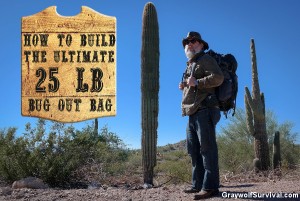





Looks good and very simple to construct.
Very simple and very flexible. Just a new take on an old idea.
Where can I get a parts list. Would be great in my tent trailer!
Hmm. Each of these designs has a pretty extensive description of how to put it together but I don’t know their full list. I have a design of my own that I’ll be posting once monsoon season ends and I can test it fully but I still have about 10% more to go. Mine should be cheaper and work better but I need to do some real measurements.
Water can either be replenished occasionally or filled with a hose with the input controlled with a cheap swamp cooler float that’s either gravity-fed or with some kind of pump. The system won’t operate without a supply of water but how you do it depends on your water situation.
I’m in the business of making pc’s and when you where talking about how the downside to the fan you got was the amount of power it took I thought of the Cooler Master MegaFlow 200. It is a computer fan with 110 cfm. I saw it on http://www.newegg.com for 20 bucks (can probably find it on Amazon too)
corrugated dryer vent? Some newer ones collapse down pretty small. Also some kids tunnels made of springy wire that returns to its original shape.
I may end up using something like that in a version of it. The problem is that they’re not insulated so the air will heat up as it goes in. The insulated ones are pretty stiff and heavy so they’d require additional support.
I have a few ideas I’m tossing around but just gotta get out and put them together.
I love this idea! Thanks for posting, specially the details:) The simplicity of your system is not only easy and quick set-up, but most importantly CHEAP! Which is always a plus in my book. I’am goin’ place one in my workshop if it meets my needs, plan to attempt to integrate your evap cooler to my greenhouse aquaponic system plans! Of course my FAV bonus is now it willn’t be so hard to talk my husband into camping, if i can promise a cool tent!=’) North Texas is pretty hot & dry in the summer time.
Nice! Don’t forget this version here too if you need something a bit bigger – http://graywolfsurvival.com/3467/diy-portable-camping-pvc-pipe-evap-air-conditioner/
Awesome- I like the larger one, too. Thanks:) Most likely better for my shop, but a little nervous about the openness of that one. I’ve got animals and kids, I see problems in keeping them out of it and clean. At least, not w/o modification that would cause more trouble than it’s worth
this is great
We are 68+ year old seniors living in a small condo in FL. Where do we start and how would we find a place to bug out? We have watched Preppers and ran across your site. We are not very able bodied, but would love to get involved. Any help anyone might give would be greatly appreciated. We don’t even have a weapon of any sort! Thank you for having this web site.
Nana and Pop
Hi Nana
Try this link. It should give you some ideas.
How should a senior citizen prepare for SHTF?
Graywolf,
I don’t see your design using the components you described – what am I missing?
http://graywolfsurvival.com/3467/diy-portable-camping-pvc-pipe-evap-air-conditioner/
i hope this works!
How did the pump work out? Would your recommend buying that one or a different one?
Love it great post and great way to cool things down I wish I had something like that when we went camping when the kids were young . We use to put the kids in plastic buckets in the tent to help keep then cool when day were 40 deg c plus
I had a great time making this project. I used the components you suggested including the Attwood blower.
For power, I bought the Noco Genius Boost GB70 and everything works well but I can only seem to keep it running for about 3 hours. How can I get this thing to run longer?
Thanks for posting this. It looks great and I’m going to build one for my RV.
Do you think a collapsible bucket would work? That could save some space, tho the cooler pads are so large that a real bucket may be the right size to hold everything.
I built one of these this past summer and it worked pretty well… Interesting to see the examples you’ve provided and i might alter mine a bit to see if i can get more efficiency…
wish I could send to my email to save this article.